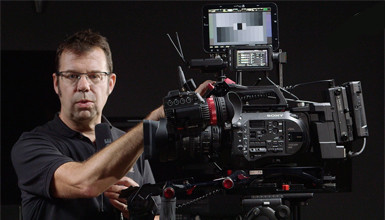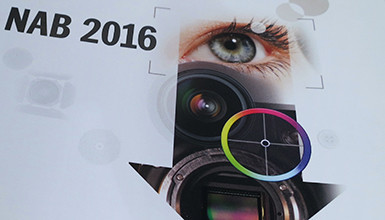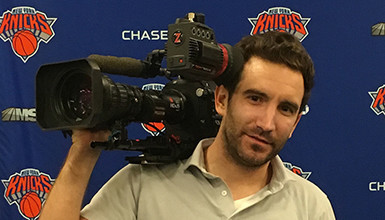In Custom mode, it can be treated like a broadcast video camera, with traditional gain settings and video-friendly frame rates. In CINE-EI mode, it can be treated like a high-end digital cinema camera, using exposure indexing and shutter angles from the world of film and scripted narrative. Its "cat-on-a-shoulder" design and included grip with camera controls is reminiscent of the cinema veritè-style cameras of the 1960s, 70s and 80s, but fully updated for the digital age.
Sporting the same Super 35 size sensor and color filter array as its much bigger brother the F5, and featuring both UHD and full DCI 4K resolutions, the FS7 is capable of truly stunning image quality in whatever mode you choose to shoot it in. Not surprisingly, a wide variety of lenses and accessories have been developed around this camera. Let's take a look at some of the standouts in the field.
Lens Adapters | Lenses | Support Systems | External Recorders | Batteries & Power Options | Audio | Additional Accessories
Lens Adapters
The FS7 features Sony's E-Mount, which some may know from Sony's popular line of mirrorless cameras. In addition to lenses from Sony, Zeiss and others, this mount can also be adapted to a wide variety of lenses due to its very shallow flange depth. Here are some good options to look at if you have existing lenses in popular mounts from the still or motion world.
Canon EF to Sony E
As with other E-mount cameras, the FS7 can be adapted to Canon EF using the Metabones Canon EF to Sony NEX Mark IV. The Mark IV allows for full electronic aperture control and supports the auto-detect APS-C feature when using Canon EF-S lenses. Another popular option is the Canon EF to Sony NEX Speedbooster ULTRA, also from Metabones. The Speedbooster is a reducing optic which gives the mounted lens a field of view similar to a "full frame" 35mm (24x36mm) camera, like the a7S or Canon 5D Mk III. What's more, the lens actually gains a stop of light in the bargain.
PL Mount to Sony E
You can easily adapt the FS7 to PL-mount cine lenses with adapters from Wooden Camera, 16x9, Solid Camera, and Vocas. As a general rule of thumb, when shooting with PL lenses it's a good idea to use lens support or the support system included with each PL adapter.
Sony Alpha to E
Sony A-mount lenses can also be used on the FS7 using adapters from Sony. The LA-EA3 has an aperture mechanism and supports auto exposure. Like the LA-EA3, the LA-EA4 allows for aperture control but adds a built-in translucent mirror that allows for phase detect autofocus.
B4 to E
An interesting and unique option, which will be enabled by 2K Center Scan mode (coming soon in the 3.0 firmware update to the FS7), is the IB/E HDx1.4 adapter. In conjunction with the Universal Mount System, which supports native Sony E-mount, the HDx1.4 allows 2/3" ENG HD lenses to be mounted on the FS7. It works by expanding the B4-mount lens' image to cover Super 16 -- the perfect size for 2K Center Scan mode. Best of all, less than a stop of light is lost with the adapter. Note: lens support is a must with these lenses due to the nature of the FS7's lens mount.
If you're looking to shoot B4-mount lenses in full UHD (or 4K DCI) -- in a sports or broadcast application, for example -- IB/E's HDx35 Mark II adapter will expand your B4 lens' image circle to completely cover the FS7's sensor while maintaining its "classic" field of view on 2/3" HD sensors. Though 2.5 stops of light are lost in the conversion, this opens up a world of possibilities for broadcast lenses -- many of which are capable of resolving 4K -- on the FS7. The Mark II includes a 3/8-16 threaded hole and two posts for lens support.
Lenses
Sony E Mount Lenses
Sony has an ever-increasing line of E-mount lenses, and they have teamed up with Zeiss on the design of several of their newest models. The power zoom Sony FE PZ 28-135mm f/4 G OSS is a flexible and functional "kit" lens for the FS7, featuring a constant f/4 aperture across the zoom range as well as image stabilization. It's built like a traditional video lens, with minimal breathing while focusing and a large focus ring with a full manual mode for precise focus. It's also parfocal, maintaining focus throughout the zoom range.
Two other versatile options are the full-frame Sony Vario-Tessar T* FE 24-70mm f/4 ZA OSS lens and the APS-C Sony Vario-Tessar T* E 16-70mm f/4. Another good choice in Sony's G series is the 70-200 f/2.8 G SSM II.
Zeiss CP.2 Lenses
Zeiss CP.2 prime lenses are lightweight and built for cinema applications, each featuring a 14-blade iris and a long focus throw. Their unique interchangeable lens mounts -- including the FS7's native E-mount -- make these lenses a great choice for the camera when serving in a digital cinema role. They're also about as "future-proof" as cine lenses get since they easily cover even full-frame sensors.
Zeiss Loxia Lenses
Originally designed for mirrorless still cameras, these compact and smooth manual focus full-frame prime lenses from Zeiss are high performers. Additionally, their apertures can be easily de-clicked with a small screwdriver to enable smooth iris adjustments.
Canon EOS Lenses
Canon's well-known line of EOS lenses are all supported on the FS7 when used with the Metabones Mark IV adapter. From specialty lenses like the various tilt-shift options to fast f/1.2 primes, there are over 60 Canon EF lenses to choose from. For versatility, our perennial favorites include: the 16-35mm f/2.8, 24-70m f/2.8 II, and the 70-200mm f/2.8 II. The 17-40mm f/4 and 70-200 f/4 lenses are great options for the run-&-gun shooter since the lenses are a bit lighter.
The 24-105mm f/4 bears special mention as a great all-rounder. It's an especially popular choice with our clients, often used in conjunction with a Metabones Speedbooster ULTRA to maintain its broad field of view on the wide end.
A good match for the hybrid video/cinema nature of the FS7 is Canon's Cine-Servo 17-120mm t2.95-3.9. It features high optical resolution and a full external servo control for drama, documentary and other broadcast productions. The servo control and handgrip are removable and instantly transform it from a broadcast-style lens into something more at home on a film set (ready to use with a follow focus, matte box, etc). As with other large lenses, make sure the lens is properly supported at all times while on the camera.
Sony A Mount Lenses
An attractive option in a fast wide zoom is Sony's Zeiss-branded 16-35mm f/2.8 ZA SSM Vario-Sonnar T* Lens. Well regarded optically, this lens is available in Sony's A-mount and can be used on the FS7 with either of the A-mount adapters detailed earlier in this article.
Support Systems
Baseplates/Shoulder Pads & Grip Accessories
Once you've chosen lenses, the next step is to build up, or "rig," your camera for handheld and studio use. Several high quality baseplates with integrated shoulder pads are available. We like the Vocas baseplate for the FS7, which includes a VCT connection for tripod use and 15mm rod receivers. Baseplates like this support the hybrid nature of this camera, allowing operators to go from sticks to shoulder mount in seconds. Also look at Zacuto's Recoil baseplate. It's available in a kit with the Axis Mini monitor/loupe arm which moves the viewfinder assembly forward on the camera for easier viewing. Both the Vocas and Zacuto include rosette attachments allowing you to mount the camera's handgrip and extension arm on the baseplate itself.
Speaking of extension arms, the clever (and toolless) Remote Extension Handle from SHAPE features push-button operation and a handy thumbscrew for adjusting extension length. Additionally, it can be folded back to be level with the base of the camera, allowing the whole rig to be set down on a flat surface.
Head/Tripod Systems
For studio or location support, check out the Sachtler 0775 FSB-8 Tripod System with Speed Lock 75 Tripod. It's a professional-level system using Sachtler's excellent FSB-8 fluid head, sliding quick-release plate, two-stage carbon fiber legs and mid-level spreader with a total capacity of 20lbs. Another great choice is the Miller Compass 12 Solo, available with either two-stage alloy or three-stage carbon fiber legs and supporting a 22-pound payload. Both the Sachtler and Miller systems use 75mm bowls. Either Sony's VCT14 or Zacuto's VCT Baseplate would work to make the VCT connection on the tripod head itself.
External Recorders
The Convergent Design Odyssey 7Q/7Q+ is a highly capable monitor/recorder with some special features tailored to the FS7. The monitor side features a color-accurate 7.7" OLED screen with 1280x800 resolution. Several image analysis and focus-assist features are available (waveform monitor, false color, focus peaking and zoom) as well as a custom viewing LUT for the FS7 when shooting in CINE-EI mode using SLog-2 or SLog-3. Recording is done to dual-SSD blades and can be in HD, 4K Apple ProRes 422(HQ), or uncompressed DPX files. A RAW option is available for purchase which allows you to record RAW video from the FS7 when used in conjunction with the XDCA-FS7 Extension Unit (see below). Considering everything it does, the Odyssey may be a better choice in some applications than the much more expensive Sony AXS-R5 RAW Recorder. For more information on recording RAW from the FS7, please see this blog post by Ian McCausland.
Sony's XDCA-FS7 extension unit attaches to the back of the FS7, providing additional inputs and outputs, as well as the ability to export RAW over SDI to a RAW recorder such as Sony's AXS-R5 or the Odyssey 7Q/7Q+ (see above). It also enables ProRes 422 recording internally to XQD media, as well as providing genlock and timecode in and out. In addition, it gives the FS7 a wealth of power options (more about that below).
Batteries & Power Options
To power the FS7, Sony uses their BPU series of batteries familiar to users of XDCAM cameras (such as the EX1). These are 14.4v batteries available in 23, 56 and 85 watt-hour capacities and feature on-battery charge meters as well as smart communication with the camera for precise display of time remaining in the viewfinder. To keep your batteries charged, especially if you're using more than one, we like multi-position charging stations from Dolgin Engineering. Their TC200-EX model will charge two BP-U60 batteries simultaneously while the TC200-EX-i adds an optional battery test/discharge module which cycles the battery through charge-discharge-charge and reports true capacity as tested. Both are available in four-position versions as well.
In addition to RAW output and ProRes recording features (see above), the XDCA-FS7 extension unit also provides a bonanza of power options for the FS7. It features a V-mount battery terminal for larger, professional batteries, such as the Switronix HyperCore 98Wh V-Mount battery, a 4-pin XLR connection for drawing power from a block battery or the wall, and a 4-pin Hirose for accessories (such as wireless audio or a monitor) and run/stop functionality.
If you don't need the XDCA-FS7's output and recording functions, the new V-Mount Jetpack from Switronix provides flexible power options as well. It includes two p-tap outputs, a 5v Lemo output, two 4-pin Hiroses and a 4-pin XLR input. It even has a USB port for digital devices like audio recorders (or to charge your iPhone while on set). It's available in either V-mount or 3-stud (also known as Gold Mount or Anton Bauer). A simpler (and cheaper) solution, also from Switronix, are their V-Mount and 3-stud battery plates, which feature 4-pin XLRs and two p-taps in addition to battery terminals.
Also take a look at Wooden Camera's battery plate. It has two D-tap connections and a right side cable for easy connection to the camera's DC-in. Used in conjunction with their sliding plate, it makes for a highly adjustable battery system and provides pass-through rails to mount clamps, arms and other accessories on the rear of the camera.
Audio
We'll be covering audio scenarios for the FS7 in-depth in a forthcoming blog post, but for now we wanted to mention two unique accessories from Sony that take advantage of the FS7's Multi-Interface (MI) shoe, located on the camera's top handle. Firmware version 2.0 for the FS7, released earlier this year, added two additional audio channels which can be accessed via accessories placed in the MI shoe.
Sony's SMAD-P3 adapter allows you to connect UWP-D series wireless receivers directly to the camera, eliminating the need for connecting cables. Without XLR cables, wireless receivers (such as with Sony's UWP-D16 wireless lavalier/plug-on combo kit) kit can ride discreetly on the top handle, out of the way. The adapter can draw power for the receiver directly from the camera which can control power on/off, unifying power management. It also works with a wide variety of Sony cameras from camcorders to handycams to mirrorless still cameras such as the A7 series. At only about $60, the SMAD-P3 falls firmly into the "no-brainer" category for us.
Another audio accessory enabled by the FS7's MI shoe and firmware version 2.0 is the XLR-K2M module which adds two additional XLR inputs to the camera. The XLR-K2M has individual level controls for each channel and even has the ability to provide phantom power to both jacks, allowing four separate mics to be powered off a single FS7 camera.
When shooting the FS7 in a broadcast or documentary role, an on-camera mic is a key accessory (the FS7 does have a small scratch mic rear right on the camera body, but it's really only for operator remarks and sync cues). We recommend a package consisting of Sennheiser's ME64 with K6P powering module, Rycote 5cm Classic Softie windshield (with their mic clamp/hot shoe adapter) and a balanced 12" jumper cable from Remote Audio.
Additional Accessories
A couple of other accessories you might need, especially if you're using the FS7 in a digital cinema application, are a matte box and follow focus.
For a compact and lightweight matte box solution, look to Bright Tangerine's Misfit. The core box assembly and adjustable flags are made from carbon fiber for a superb weight-to-strength ratio. It can be used as a clamp-on or swing away matte box with the addition of a lightweight arm. The design accommodates lenses as wide as 14mm (such as a Cooke S4) with no vignetting and easily switches between two or three filter stages. Our favorite touch: above the french flag (or "eyebrow") there's an adjustable glide rail with a 3/8" mounting point. Here, you could attach an on-camera light, small monitor or even a binocular rangefinder (such as from Cinetape or Arri) for ultra-precise focus pulls.
To make those pulls, you'll need a follow focus. The new MFC-2S from Vocas is a professional-level follow focus designed for use with cine-style lenses that have long focus throws. Featuring a 1.175:1 gear ratio, it easily clamps onto lightweight 15mm rods. It's also reversible. A limited edition, which will be available soon, features a walnut wood knob and handrest, giving the entire unit a premium, old-world feel.













